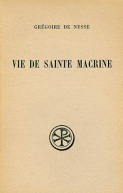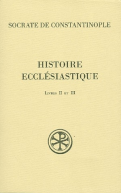
SC 477 Histoire ecclésiastique, I
Collection Sources chrétiennes - N° 477
280 pages - déc. 2003
36,00€
L'« Histoire Ecclésiastique » de Socrate, un écrivain constantinopolitain du début du Ve siècle, entend poursuivre celle d'Eusèbe de Césarée : elle commence donc avec le règne de Constantin (306-337) pour s'achever en 438, sous Théodose II. Le livre I est entièrement consacré au règne de Constantin, dont l'ascension vers le pouvoir est brièvement évoquée, avant que soient passés en revue les événements importants de l'histoire du christianisme sous son long règne : le concile de Nicée (325), la politique religieuse de l'empereur, quelques-unes des grandes figures épiscopales et monastiques du temps, la conversion de peuples barbares (Axoumites, Géorgiens), la découverte du tombeau et de la croix du Christ, les problèmes suscités par le concile en Orient. Socrate offre l'avantage de citer in extenso nombre de documents importants, lettres d'évêques, de l'empereur, du concile ; d'autre part son « Histoire », à l'inverse d'autres, n'est pas une histoire de combat, mais fait preuve d'un certain irénisme, dû sans doute à l'appartenance de son auteur à l'Église dissidente (mais fidèle à Nicée) des novatiens.
--
The ‘’Ecclesiastical history” of Socrates, a writer who spent most of his life in Constantinople at the beginning of the 5th century, takes up where Eusebius of Caesarea left off. So it begins with the reign of Constantine (306-337) and ends in 438, under Theodosius II. Book One is entirely devoted to the reign of Constantine, whose rise to power it briefly describes, before reviewing the succession of important events in the history of Christianity under his long reign: the Council of Nicaea (325), the emperor’s religious strategy, some of the great Episcopal and monastic figures of the times, the conversion of the Barbarians (Axumites, Georgians), the discovery of Christ’s cross and tomb, the problems created by the council in the Eastern Empire. Socrates has the advantage of quoting in extenso many essential documents: letters from bishops, the emperor, the council. Moreover, his ‘history’, unlike any other, is not a history of warring: it reveals a certain irenism, probably due to the fact that its author belonged to the dissident Church (though faithful to Nicaea) of the Novatians.
--
The ‘’Ecclesiastical history” of Socrates, a writer who spent most of his life in Constantinople at the beginning of the 5th century, takes up where Eusebius of Caesarea left off. So it begins with the reign of Constantine (306-337) and ends in 438, under Theodosius II. Book One is entirely devoted to the reign of Constantine, whose rise to power it briefly describes, before reviewing the succession of important events in the history of Christianity under his long reign: the Council of Nicaea (325), the emperor’s religious strategy, some of the great Episcopal and monastic figures of the times, the conversion of the Barbarians (Axumites, Georgians), the discovery of Christ’s cross and tomb, the problems created by the council in the Eastern Empire. Socrates has the advantage of quoting in extenso many essential documents: letters from bishops, the emperor, the council. Moreover, his ‘history’, unlike any other, is not a history of warring: it reveals a certain irenism, probably due to the fact that its author belonged to the dissident Church (though faithful to Nicaea) of the Novatians.
- Dimensions : 125x195x20
- ISBN : 9782204072144
- Poids : 340 grammes
Avec la collaboration de : Pierre Maraval, Pierre Périchon
DU MÊME AUTEUR
> VOIR TOUS LES LIVRES DE l'AUTEUR
DANS LA CATÉGORIE
Premières Communautés chrétiennes (Les) - LD 188
Traditions et tendances dans le christianisme des origines
de Vittorio Fusco
384 pages - avril 2001
SC 122 Traités théologiques et éthiques, I : Théol. I-III, Éth. I-III
Théol. I-III, Éth. I-III
de Syméon le Nouveau Théologien
456 pages - sept. 1976










